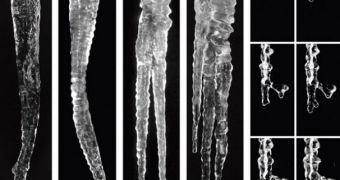In a new set of scientific studies, it was revealed that scientists don't know as much as they thought they did about how frozen cones drip, and icicles form.
For many years, it was believed that samples featuring a precise quantity of water, freezing under the same conditions, would create icicles that feature the same form.
This was recently proven wrong, after investigations in which experts grew large numbers of icicles in the precisely-controlled confines of a scientific laboratory, Wired reports.
The new data would seem to indicate that the icicles have no tendency to organize themselves in the same shape. A wide range of variation was identified, which stands against existing theories.
The group that conducted the new research published its findings in the August 11 online issue of the journal arXiv, and also in a series of YouTube videos.
The work was led by physicists Stephen Morris and Antony Szu-Han Chen, who are both based at the University of Toronto, in Canada.
They started work on analyzing how cones and icicles develop because, “as far as we know, no one has really systematically studied the shape of icicles and how they grow,” says Morris.
“Nobody has really tried to fill in the physics of how the shape emerges,” he adds. Existing theories hold that breaking an icicle along its length would result in a fragment the same shape as the whole structure.
In the experiments, the team developed a device that was capable of fostering the growth of several icicles at the same time.
The machine was made out of a refrigerator box, with a water drip mechanism at the top and a rotating platform to ensure that all icicles got the same amount of drips.
The team learned that the existing theories, which state that the icy structures form in an ideal shape when in still air, are wrong.
It was discovered that the most ideally-shaped icicles were actually produced in the presence of moving air, whereas those produced in still air had little odd “legs” at their end.
Studying icicles goes beyond making better ice cream, the experts say. The work holds vital importance for airplane and power line safety.
“If you can’t understand an icicle, you’re not going to understand how ice develops on a fast-blowing airplane wing,” Morris concludes.

 14 DAY TRIAL //
14 DAY TRIAL //